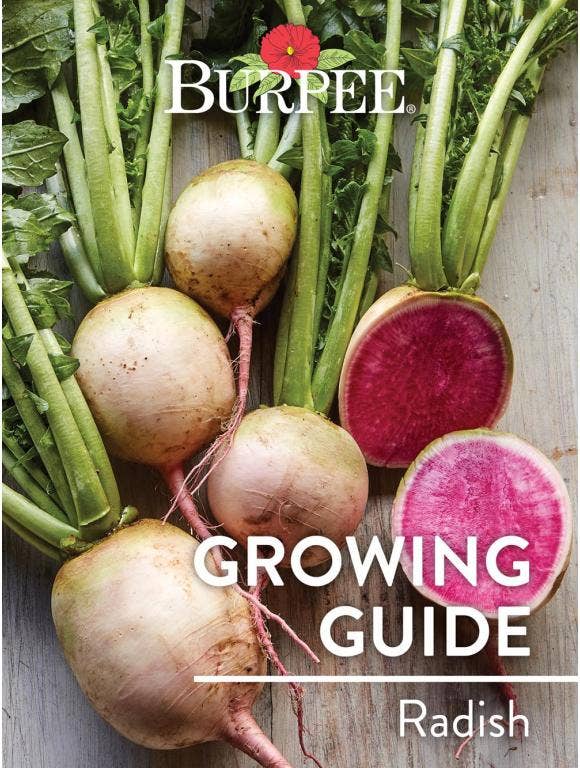
How to Sow
- Sow radish seeds in well-worked soil after danger of frost in early spring, again in late summer for fall crop. In frost free areas, sow in the fall.
- Sow thinly in rows about 6" apart. Cover with 1/2" of fine soil; firm lightly and keep evenly moist.
- Seedlings emerge in 4-6 days.
- Thin to stand about 2" apart.
- Sow winter radishes in midsummer for late fall and winter use. They can grow large with several inches of root showing above ground.
How to Grow
- Keep weeds under control during the growing season. Weeds compete with plants for water, space and nutrients, so control them by either cultivating often or use a mulch to prevent their seeds from germinating.
- Water continuously and evenly. Avoid over-fertilizing radish plants.
- Keep plants well watered during dry periods to promote uninterrupted growth. Plants need about 1 inch of rain per week during the growing season. Use a rain gauge to check to see if you need to add water. It’s best to water with a drip or trickle system that delivers water at low pressure at the soil level. If you water with overhead sprinklers, water early in the day so the foliage has time to dry off before evening, to minimize disease problems. Keep the soil moist but not saturated.
- Monitor for pests and diseases. Check with your local Cooperative Extension Service for pest controls recommended for your area.
Harvest and Preserving Tips
- Pull spring radishes when they are the proper size for the type, about 25 days after planting. If you wait too long to harvest they will become pithy. Push back the soil to see if they have formed bulbs, and taste one or two to see if they are ready. Finish harvest before warm weather comes.
- Cut off the tops and store in plastic bags at 32-40 degrees F, in the refrigerator, for up to 3 weeks.
- Harvest winter or fall radishes as needed in fall. Dig all remaining roots before the ground freezes and store throughout the winter (use as needed).
- Radishes may be eaten raw in salads or sautéed in butter with salt, pepper and herbs as a side dish. Winter radishes may be cooked like turnips or used in stir fry. They may also be pickled.
Common Disease Problems
Alternaria Leaf Spot: Small, round reddish brown spots with white to gray centers for on the upper surface of the leaves. The lesions may encircle the stems and cause wilt. This disease is worse in warm, wet or very humid weather. Burpee Recommends: Avoid getting water on the foliage. Remove infected plant parts and do not work around wet plants. Provide plenty of air circulation. Contact your Cooperative Extension Service for fungicide recommendations.
Black Root: This mostly affects long rooted radishes. It is caused by a soil borne fungus and causes lesions which expand and girdle roots. Burpee Recommends: Rotating crops. If the problem is persistent try planting round varieties.
Downy Mildew: This fungus causes whitish gray patches on the undersides and eventually both sides of the leaves. Burpee Recommends: Rotate crops with plants in a different family. Avoid overhead watering. Provide adequate air circulation, do not overcrowd plants. Do not work around plants when they are wet.
Scab: This disease causes brown and yellow circular lesions on the roots. The lesions become sunken and cracked, irregular and coalesce. Burpee Recommends: Do not plant radishes or other members of the brassica family in the same area for at least four years. Try container growing.
Yellows: Plants are stunted and develop yellow leaves. This virus-like condition is spread by leafhoppers. Burpee Recommends: Remove infected plants and control leafhoppers. Remove weeds in the area which serve as alternate hosts to the disease.
Common Pest and Cultural Problems
Aphids: Greenish, red, black or peach colored sucking insects can spread disease as they feed on the undersides of leaves. They leave a sticky residue on foliage that attracts ants. Burpee Recommends: Introduce or attract natural predators into your garden such as lady beetles and wasps which feed on aphids. You can also wash them off with a strong spray, or use an insecticidal soap.
Cabbage Root Maggot: These insects live in the soil and feed off the plant roots. Burpee Recommends: Your Cooperative Extension Service may recommend a soil drench prior to planting. A flat band or collar of thick paper around the base of the plants, or floating row covers, may help prevent the adult flies from laying eggs at the base of the stems.
Cracked Roots: This may occur when the roots are not harvested early enough.
Flea Beetles: These small hopping beetles feed on plant foliage. Burpee Recommends: Rotate crops with plants in a different plant family. Use floating row covers to prevent damage to young foliage.
Leafhoppers: Leafhoppers cause injury to leaves and stunt growth. They also spread disease. Burpee Recommends: Remove plant debris. Use insecticidal soaps. Consult your Cooperative Extension Service for other insecticide recommendations.
Radish FAQs
Why didn’t my radish form a bulb? Radish roots are sensitive to overcrowding and hot weather. Another possibility is the soil was not loose and friable enough.
Why are my radishes woody? Radishes are a cool season crop and will turn woody when they are harvested too late in the season.
My radishes are blooming! Your radishes have bolted, which often occurs when the weather becomes hot. At this point you should pull them up and discard them as they will not be edible.
Can I eat my radish thinnings? Yes, radish sprouts are edible.
Can I grow radishes in containers? Radishes are perfect for container growing. Use a commercial potting mix rather than garden soil and make sure they have enough room to develop fully according to the variety.


